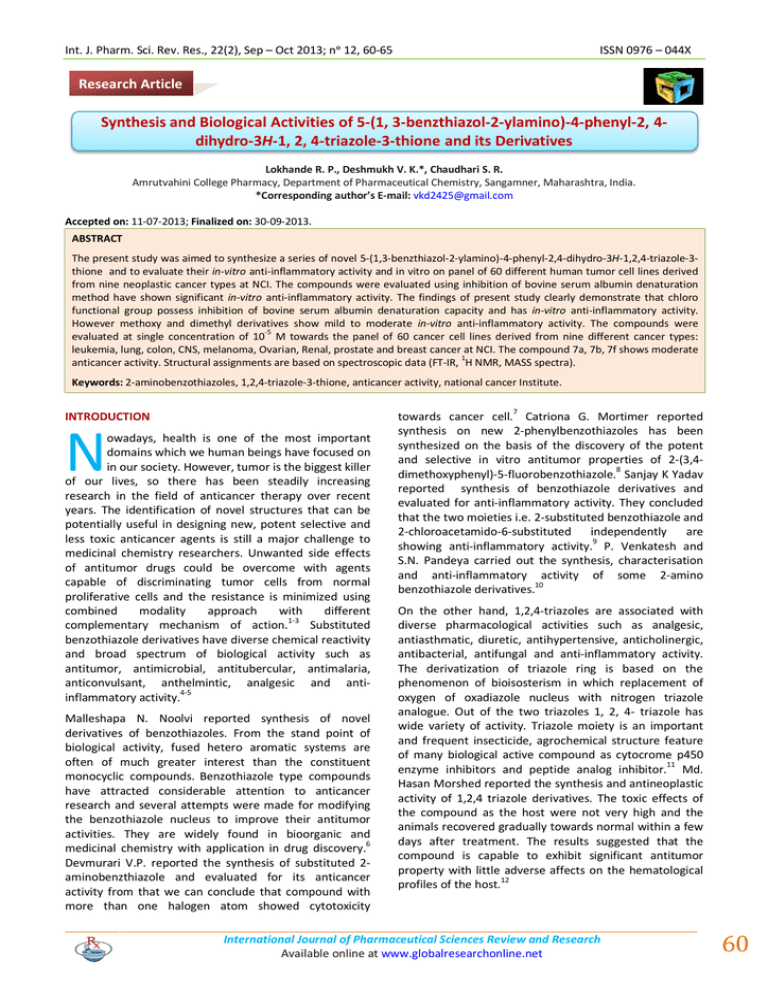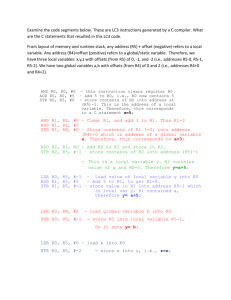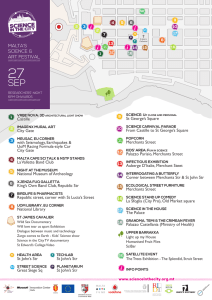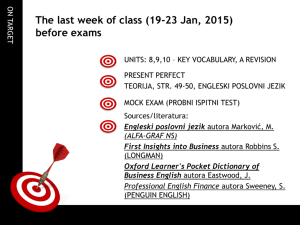Document 13309326
advertisement

Int. J. Pharm. Sci. Rev. Res., 22(2), Sep – Oct 2013; nᵒ 12, 60-65
ISSN 0976 – 044X
Research Article
Synthesis and Biological Activities of 5-(1, 3-benzthiazol-2-ylamino)-4-phenyl-2, 4dihydro-3H-1, 2, 4-triazole-3-thione and its Derivatives
Lokhande R. P., Deshmukh V. K.*, Chaudhari S. R.
Amrutvahini College Pharmacy, Department of Pharmaceutical Chemistry, Sangamner, Maharashtra, India.
*Corresponding author’s E-mail: vkd2425@gmail.com
Accepted on: 11-07-2013; Finalized on: 30-09-2013.
ABSTRACT
The present study was aimed to synthesize a series of novel 5-(1,3-benzthiazol-2-ylamino)-4-phenyl-2,4-dihydro-3H-1,2,4-triazole-3thione and to evaluate their in-vitro anti-inflammatory activity and in vitro on panel of 60 different human tumor cell lines derived
from nine neoplastic cancer types at NCI. The compounds were evaluated using inhibition of bovine serum albumin denaturation
method have shown significant in-vitro anti-inflammatory activity. The findings of present study clearly demonstrate that chloro
functional group possess inhibition of bovine serum albumin denaturation capacity and has in-vitro anti-inflammatory activity.
However methoxy and dimethyl derivatives show mild to moderate in-vitro anti-inflammatory activity. The compounds were
-5
evaluated at single concentration of 10 M towards the panel of 60 cancer cell lines derived from nine different cancer types:
leukemia, lung, colon, CNS, melanoma, Ovarian, Renal, prostate and breast cancer at NCI. The compound 7a, 7b, 7f shows moderate
1
anticancer activity. Structural assignments are based on spectroscopic data (FT-IR, H NMR, MASS spectra).
Keywords: 2-aminobenzothiazoles, 1,2,4-triazole-3-thione, anticancer activity, national cancer Institute.
INTRODUCTION
N
owadays, health is one of the most important
domains which we human beings have focused on
in our society. However, tumor is the biggest killer
of our lives, so there has been steadily increasing
research in the field of anticancer therapy over recent
years. The identification of novel structures that can be
potentially useful in designing new, potent selective and
less toxic anticancer agents is still a major challenge to
medicinal chemistry researchers. Unwanted side effects
of antitumor drugs could be overcome with agents
capable of discriminating tumor cells from normal
proliferative cells and the resistance is minimized using
combined
modality
approach
with
different
complementary mechanism of action.1-3 Substituted
benzothiazole derivatives have diverse chemical reactivity
and broad spectrum of biological activity such as
antitumor, antimicrobial, antitubercular, antimalaria,
anticonvulsant, anthelmintic, analgesic and antiinflammatory activity.4-5
Malleshapa N. Noolvi reported synthesis of novel
derivatives of benzothiazoles. From the stand point of
biological activity, fused hetero aromatic systems are
often of much greater interest than the constituent
monocyclic compounds. Benzothiazole type compounds
have attracted considerable attention to anticancer
research and several attempts were made for modifying
the benzothiazole nucleus to improve their antitumor
activities. They are widely found in bioorganic and
medicinal chemistry with application in drug discovery.6
Devmurari V.P. reported the synthesis of substituted 2aminobenzthiazole and evaluated for its anticancer
activity from that we can conclude that compound with
more than one halogen atom showed cytotoxicity
towards cancer cell.7 Catriona G. Mortimer reported
synthesis on new 2-phenylbenzothiazoles has been
synthesized on the basis of the discovery of the potent
and selective in vitro antitumor properties of 2-(3,4dimethoxyphenyl)-5-fluorobenzothiazole.8 Sanjay K Yadav
reported synthesis of benzothiazole derivatives and
evaluated for anti-inflammatory activity. They concluded
that the two moieties i.e. 2-substituted benzothiazole and
2-chloroacetamido-6-substituted independently are
showing anti-inflammatory activity.9 P. Venkatesh and
S.N. Pandeya carried out the synthesis, characterisation
and anti-inflammatory activity of some 2-amino
benzothiazole derivatives.10
On the other hand, 1,2,4-triazoles are associated with
diverse pharmacological activities such as analgesic,
antiasthmatic, diuretic, antihypertensive, anticholinergic,
antibacterial, antifungal and anti-inflammatory activity.
The derivatization of triazole ring is based on the
phenomenon of bioisosterism in which replacement of
oxygen of oxadiazole nucleus with nitrogen triazole
analogue. Out of the two triazoles 1, 2, 4- triazole has
wide variety of activity. Triazole moiety is an important
and frequent insecticide, agrochemical structure feature
of many biological active compound as cytocrome p450
enzyme inhibitors and peptide analog inhibitor.11 Md.
Hasan Morshed reported the synthesis and antineoplastic
activity of 1,2,4 triazole derivatives. The toxic effects of
the compound as the host were not very high and the
animals recovered gradually towards normal within a few
days after treatment. The results suggested that the
compound is capable to exhibit significant antitumor
property with little adverse affects on the hematological
12
profiles of the host.
International Journal of Pharmaceutical Sciences Review and Research
Available online at www.globalresearchonline.net
60
Int. J. Pharm. Sci. Rev. Res., 22(2), Sep – Oct 2013; nᵒ 12, 60-65
ISSN 0976 – 044X
Taking in to consideration of literature review, it was clear
that very little literatures were available for substituted 5(1,
3-benzothiazol-2-ylamino)-2,4-dihydro-3H-1,2,4triazole. So we had planned to synthesise titled
compound & to screen for anticancer, anti-inflammatory
activities.
2) Synthesis of substituted ethyl 1,3-benzothiazol-2ylcarbamate .
MATERIALS AND METHODS
The solution of substituted ethyl 1,3-benzothiazol-2ylcarbamate (0.01mol) and N-1,3-benzthiazol-2-yl 2(phenylcarbamothioyl)hyddazinecarboxamide
(0.01
mol) in ethanol (25 ml) refluxed independently for 4 hr.
The residue was concentrated, cooled and poured over
crushed ice to the precipitate which was filtered, wash
with water.16
Synthesis was done by as per reported method.15
3)
Synthesis
of
N-1,3-benzthiazol-2-yl
2(phenylcarbamothioyl)hyddazinecarboxamide.
Materials
Melting points were determined in open capillaries.
Reactions were monitored by thin layer chromatography
using silica gel-G as adsorbent using benzene as mobile
phase. IR spectra (KBr pellet) were recorded on Bruker α
1
FT-IR spectrometer. H NMR spectrum (DMSO-d6) were
taken on NMR Bruker Avance II 400 MHz spectrometer
from Punjab University, Chandigarh. Physicochemical
parameters of synthesized compounds are depicted in
table no.1
-
4) Synthesis of 5-(1,3-benzthiazol-2-ylamino)-4-phenyl2,4-dihydro-3H-1,2,4-triazole-3-thione
A mixture of substituted N-1,3-benzthiazol-2-yl 2(phenylcarbamothioyl) hyddazine carboxamide (0.001)
and 30 ml of 2 % aq. sodium hydroxide solution was
refluxed independently for 6 hr. After completion of
reaction mixture was filtered and filtrate was neutralized
with conc. HCl drop wise till pH was adjusted to 7. The
mixture was kept aside for few minutes and filter.
Recrystallized from ethanol.17
Synthesis procedure
1) Synthesis of N-phenylhydrazinecarbothioamide.
Synthesis was done by as per reported method. 13-14
SCEHME:
Step:1
NH
NH2
+
NH 4SCN
NH2
NH
+ NH 2NH 2 Ethylene glycol
Conc HCl
NH
NH2
S
S
Step:2
O
O
N
N
R
ClCOOC 2H 5 R
NH2
NH
Pyridine
S
CH3
S
Step:3
S
NH
N
NH
N
R
S
NH
NH2
+
NH
S
COOC2H5
NH
NH
S
NH
O
Ethanol
R
Step:4
S
NH
N
NH
S
R
NH
O
R
NH
N
NaOH
S
H
N N
NH
N
International Journal of Pharmaceutical Sciences Review and Research
Available online at www.globalresearchonline.net
S
61
Int. J. Pharm. Sci. Rev. Res., 22(2), Sep – Oct 2013; nᵒ 12, 60-65
ISSN 0976 – 044X
Table 1: Physicochemical parameters of all synthesized compounds
Comp. Id.
R
Mol. Formula
Mol. Wt
m.p.°C
*Rf Value
%Yield
7a
4Cl
C15H10ClN5OS2
359.85
232-234
0.73
55
7b
5Cl
C15H10ClN5OS2
359.85
244-246
0.67
53.83
7c
6Cl
C15H10ClN5OS2
359.85
240-242
0.68
55.23
7d
4OCH3
C16H13N5OS2
355.43
262-264
0.70
51.11
7e
5OCH3
C16H13N5OS2
355.43
232-234
0.62
52.87
7f
6OCH3
C16H13N5OS2
355.43
220-222
0.66
52.42
7g
6NO2
C15H12N6O3S2
388.85
180-182
0.64
60.11
7h
6Br2
C15H10N5S2 Br
404.30
192-194
0.72
58.69
7i
7-Cl 6-F
C15H9ClFN5S2
377.86
226-228
0.76
49.15
7j
4-7 CH3
C21H20ClFN4O2S
446.92
238-240
0.65
45.28
*Mobile phase-benzene
Table 2: Anticancer screening data of tested compounds
-5
60 cell line assay in 1-dose 10 M concentration
NSC code
(Comp No)
Most sensitive cell lines
Mean growth %
Range
Delta
% Growth
% GI
D-771857
(7a)
Leukemia
SR
99.16
59.23
32.90
66.36
33.64
D-773070
(7b)
Renal cancer
UO-31
101.71
57.76
29.26
72.45
17.99
D-773069
(7h)
Prostate Cancer
PC-3
102.30
58.75
23.75
78.55
27.55
Range= Highest Growth Percent-Lowest Growth Percent; Delta= Mean Growth Percent-Lowest Growth Percent; % GI (Percent Growth Inhibition of
most sensitive cell lines) = mean growth% -% Growth
5-(4-Chloro-1, 3-benzthiazol-2-ylamino)-4-phenyl-2,4dihydro-3H-1,2,4-triazole-3-thione (7a)
5-(4-Methoxy-1, 3-benzthiazol-2-ylamino)-4-phenyl-2,4dihydro-3H-1,2,4-triazole-3-thione (7d)
FT-IR(KBr cm-1): 3430 (N-H str.); 3025 (C-H str); 1620 (C=N
str); 1540 (C=C str); 1266 (C-S str); 730 (C-Cl str), 1H NMR
(DMSO d6): (δ, ppm): δ 4.56 (s, 1H, NH); 7.12-8.32 (m, 8H,
Ar-H); δ7.12 (s, 1H, NH), M+-359, RA-72%; M+2-361; RA25.12%; % Anal calculated; C-50.06, H-2.80; N- 19.46,
Found: C -49.90; H -2.75; N-19.53.
FT-IR (KBr cm-1) : 3355 (N-H str) ; 2987(C-H str) ;
1585
(C=N str) ; 1543(C=C str ) ; 1270 (C-S str) ; 1092 (C-0-C str),
1
H NMR (DMSO d6): 3.49 (s, 1H, OCH3); 4.11 (s, 1H, NH);
6.98 (s, 1H, NH); (7.12-8.51 (m, 8H, Ar H), M+-355; RA –
65%; % Anal. Calculated C- 54.07, H- 3.69, N- 19.70,
Found: C-54.14 , H-3.66 ,N-19.68.
5-(5-chloro-1, 3-benzthiazol-2-ylamino)-4-phenyl-2,4dihydro-3H-1,2,4-triazole-3-thione (7b)
5-(5-Methoxy-1, 3-benzthiazol-2-ylamino)-4-phenyl-2, 4dihydro-3H-1, 2, 4-triazole-3-thione (7e)
FT-IR(KBr cm-1): 3413 (N-H str); 3032 (C-H str); 1718 (C=O
str); 1601 (C=N str); 1530 (C=C str); 1277(C-S str); 733(C-Cl
str ), 1H NMR (DMSO d6) : 4.12 (s,1H,NH), 6.89 (s,1H,NH),
7.05-8.30 (m,8H,ArH), M+-359; RA-70%; M+2-361; RA21.62%; % Anal. Calculated: C-50.06; H-2.80; N- 19.46;
Found: C 50.13; H-2.88; N- 19.39.
FT-IR (KBr cm-1 ): 3440 (N-H-str) ;3095 (C-H-str); 1590
(C=N-str) ; 1524 (C=C-str); 1272 (C-S-str) ; 1099(C-O-CStr), 1H NMR (DMSO d6): 3.73 (s, 1H, OCH3) ; 4.35(s, 1H,
NH1) ; 6.26(s, 1H, NH); 6.92-8.41 (m, 8H, Ar-H), M+-355;
RA – 67%; % Anal. Calculated: C- 54.07; H- 3.69; N- 19.70,
Found: C -54.06; H- 3.56; N- 19.54.
5-(6-Chloro-1,
3-benzthiazol-2-ylamino)-4-phenyl-2,4dihydro-3H-1,2,4-triazole-3-thione (7c)
5-(6-Methoxy-1, 3-benzthiazol-2-ylamino)-4-phenyl-2,4dihydro-3H-1,2,4-triazole-3-thione (7f)
FT-IR(KBr cm-1) : 3445 (N-H str); 3031 (C-H str); 1655 (C=N
str); 1533 (C=C str); 1250 (C-S str); 740(CCl str), 1H NMR (DMSO d6): 4.02 (s, 1H, NH); 6.78 (s, 1H,
NH); 7.02-8.24 (m, 8H, Ar H); M+-359; RA-71%;M+2-361;
RA-20.55%, %Anal. Calculated: C-50.06; H-2.80; N- 19.46,
Found: C -50.01; H-2.85; N- 19.40.
FT-IR(KBr cm-1): 3385 (N-H str); 2943 (C-H str);
1675
(C=N str); 1519 (C=C str); 1288 (C-S str);1092 (C-O-C Str),
1
H NMR (DMSO d6): 3.73 (s, 1H, OCH3); 4.35 (s, 1H,
NH1); 6.26 (s,
1H,
NH); 6.92-8.41 (m, 8H, Ar-H), M+355; RA–2%; % Anal.Calculated: C-54.07; H-3.69; N19.70, Found: C-54. 06; H 3.56; N 19.54.
International Journal of Pharmaceutical Sciences Review and Research
Available online at www.globalresearchonline.net
62
Int. J. Pharm. Sci. Rev. Res., 22(2), Sep – Oct 2013; nᵒ 12, 60-65
5-(6-Nitro-1, 3-benzthiazol-2-ylamino)-4-phenyl-2,4dihydro-3H-1,2,4-triazole-3-thione (7g)
FT-IR(KBr cm-1): 3424 (N-H str); 3022(C-H str); 1630(C=N
str) ;1529 (-NO2str); 1520 (C=C str); 1264 (C1
S str) , H NMR (DMSO d6) : 4.32 (s, 1H, NH); 6.69 (s, 1H, N
H); 7.05-8.30 (m, 8H, ArH) , M+-370; RA –72%; % Anal.
Calculated: C-48.64; H-2.72; N- 22.69; Found: C-48.74; H2.68; N- 22.59.
5-(6-Bromo-1, 3-benzthiazol-2-ylamino)-4-phenyl-2,4dihydro-3H-1,2,4-triazole-3-thione (7h)
ISSN 0976 – 044X
where no drug was added. Each experiment was done in
triplicate and average was taken. The diclofenac sodium
was used as standard drug.
% of inhibition = 100 x ((Vc/Vt)-1)
Where, Vt and Vc are mean absorbance value of test
group and control group.19-21
Table 3: In vitro anti-inflammatory activity
Name of
compound
Absorbance value
(mean±SE)
Inhibition of
denaturation (in %)
FT-IR(KBr cm-1) : 3414 (N-H str); 2979 (C-H str); 1602 (C=N
str), 1530 (C=C str), 1265 (C-S str), 1H NMR
(DMSO d6) : 4.02 (s, 1H, NH); 6.89 (s, 1H, NH); 7.058.30 (m, 8H, ArH), M+- 404.30; RA –67%; %
Anal. Calculated: C-44.56; H-2.89; N- 17.32; Found: C
44.54; H-2.83; N- 17.39.
Control
0.089±0.009
--
7a
0.162±0.001
82.02
7b
0.153± 0.003
71.91
7c
0.158± 0.0013
77.52
7d
0.112+ 0.002
25.84
5-(7-chloro-6-fluro-1,3-benzthiazol-2-ylamino)-4-phenyl2,4-dihydro-3H-1,2,4-triazole-3-thione (7i)
7e
0.126±0.001
41.57
7f
0.121± 0.003
35.95
7g
0.137± 0.004
53.93
7h
0.159±0.002
78.64
7i
0.118±0.0015
32.58
7j
0.132± 0.0021
48.48
Standard
(Diclofenac
sodium)
0.173±0.001
94.38
-1
FT-IR(KBr cm ): 3389 (N-H str); 2973 (C-H str); 1632 (C=N
str); 1539 (C=C str); 1263 (C-S,str) 1100 (C-F str), 1H NMR
(DMSO d6): 4.18 (s, 1H, NH); 6.73 (s, 1H, NH); 7.058.30 (m, 7H, ArH), M+-377.84; RA–70%; % Anal.
Calculated: C-47.68; H-2.40; N- 18.53; Found: C 47.54; H2.43; N- 18.49.
5-(4-7-dimethyl-1,3-benzthiazol-2-ylamino)-4-phenyl2,4-dihydro-3H-1,2,4-triazole-3-thione (7j)
FT-IR(KBr cm-1) : 3390 (N-H str); 2954 (C-H str); 1614 (C=N
str), 1509 (C=C str), 1272 (C-S str), 1H NMR
(DMSO d6): 2.35 (s, 6H, CH3); 4.18 (s, 1H, NH); 6.73 (s,
1H, NH); 7.05-8.30 (m,7H,ArH), M+-353.456; RA – 69%.
% Anal. Calculated: C-57.77; H-4.28; N- 19.81; Found: C
57.64; H-4.33; N- 19.89.
Anticancer activity
The compounds (7a, 7b, and 7h) were screened for
preliminary anticancer assay by National Cancer Institute
(NCI), Bethesda, Maryland, USA in an in vitro 60 human
tumor cell panel derived from nine neoplastic cancer
types.18
In vitro anti-inflammatory activity
The synthesized compounds are screened for antiinflammatory activity by using inhibition of albumin
denaturation technique. The standard drug and test
compounds were dissolved in minimum amount of
dimethyl formamide (DMF) and diluted with phosphate
buffer (0.2 M, pH 7.4). Final concentration of DMF in all
solutions was less than 2.0%. Test solution (1 ml)
containing different concentrations of drug was mixed
with 1 ml of 1% mM albumin solution in phosphate buffer
and incubated at 27o ±1oC in BOD incubator for 15 min.
Denaturation was induced by keeping the reaction
mixture at 60 o ±1oC in water bath for 10 min. After
cooling the turbidity was measured at 660 nm (UV-Visible
Spectrophotometer SCHIMATZU 1800). Percentage of
inhibition of denaturation was calculated from control
RESULTS AND DISCUSSION
The purpose of the present work was to synthesize a
series of desired title compounds 5 -(1,3-benzthiazol-2ylamino)-4-phenyl-2,4-dihydro-3H-1,2,4-triazole-3thione(7a-7j) by reacting with hydrazinecarboxamide and
ethyl 1-3 benzthiazole-2-yl carbamate. Furthermore, the
procedure used commercially available reagents, giving
the desired compounds in moderate yields (45–60%). The
versatility of this methodology makes it suitable for
library synthesis in drug discovery efforts.
The compounds were evaluated at single concentration of
-5
10 M towards the panel of approximately 60 cancer cell
lines derived from nine different cancer types: leukemia,
lung, colon, CNS, melanoma, ovarian, renal, prostrate and
breast cancers. Preliminary anticancer assay was
performed according to the US NCI protocol.
The tested compounds showed a broad spectrum of
growth inhibitory activity against human tumor cells, as
well as some distinctive patterns of selectivity Fig.1.
Compound (7a) was found to have good growth inhibitor
activity against Leukemia (SR) with a growth % of most
sensitive cell line to be 64.93, whilst least active over
other cell lines. The mean growth % for compound (7a)
was observed 99.16 and fall in a range of 59.23.
Compounds (7g) and (7h) showed selectivity on renal
cancer (UO-31) with a growth % of most sensitive cell line
to be 78.91, 74.74 and respectively. Anticancer screening
data of tested compounds are depicted in table no.2.
International Journal of Pharmaceutical Sciences Review and Research
Available online at www.globalresearchonline.net
63
Int. J. Pharm. Sci. Rev. Res., 22(2), Sep – Oct 2013; nᵒ 12, 60-65
ISSN 0976 – 044X
Figure 1: One dose mean graph of compound (NSC:D-771857/1)
All the newly synthesized compounds 7a-7j was tested for
in vitro anti-inflammatory activity as compared to the
standard Diclofenac sodium. Amongst all the tested
compounds 7a, 7b,7c found with most potent activity i.e
82.02%, 71.91%, and 77.52 respectively and 7h having
78.64% inhibition of denaturation. Anti-inflammatory
screening data of tested compounds are depicted in table
no.3.
CONCLUSION
prove the necessity for further investigations to clarify the
features underlying the antitumor potential of tested
compounds.
Acknowledgments: We thank the National Cancer
Institute (NCI), Bethesda, MD, USA for in vitro screening
of our compounds in human cancer cell lines and Director
SAIF, Punjab University, Chandigarh for providing NMR
spectra and MASS spectra.
REFERENCES
In the present work ten compounds were tested and
three of them displayed antitumor activity on renal
cancer, lung cancer cell lines. Compound 7a, 7b, 7c was
found to potent anti-inflammatory activity and all are
showing good anti-inflammatory activity. Compound (7a)
was found to be active with selective influence on non
small cell lung cancer cell lines, especially on Leukemia SR
with a % growth inhibition of 33.64. The obtained results
1.
Zwick.E, Bange .J, Ullrich. A, Endocr. Relat. Cancer. 8, 2001,
161-173.
2.
Heffeter P., Jakupec M. A, Orner.W.S, Anticancer activity of
the lanthanum compound [tris(1,10phenanthroline)
lanthanum(III)]trithiocyanate (KP772,FFC24). Biochem. Pha
rmacol, 71, 2006, 426-40.
3.
Menta E., Palumbo M., Exp. Opin. Ther. Patents, 7, 1997,
1401.
International Journal of Pharmaceutical Sciences Review and Research
Available online at www.globalresearchonline.net
64
Int. J. Pharm. Sci. Rev. Res., 22(2), Sep – Oct 2013; nᵒ 12, 60-65
4.
5.
Yoshida M, Hayakawa I, Hayashi N, et al. Synthesis and
biological evaluation of benzothiazole derivatives as potent
antitumor agents. Bioorg. Med. Chem. Lett., 15(14) 2005,
3328-32.
Franchini C, Muraglia M, Corbo F, Synthesis and biological
evaluation of 2-mercapto-1,3-benzothiazole derivatives
with potential antimicrobial activity, Arch. Pharm. Chem.
Life Sci., 342, 2009, 605–613.
6.
Malleshappa N. Noolvi, Patel M., Kaur M, Benzothiazoles:
Search for anticancer agents, European Journal of
Medicinal Chemistry, 54, 2012, 447-62.
7.
Devmurari V.P, Pandey S, Goyani M.B, Nandanwar R.R,
Jivani N.P,Perumal P, Synthesis and Anticancer Activity of
Some Novel 2-Substituted Benzothiazole Derivatives,
International Journal of ChemTech Research, 2(1), 2010,
681-689.
8.
9.
Mortimer C. G, Wells G, Crochard
J. P, Stone E. L,
Bradshaw
T. D, Malcolm F. Stevens
G
and Westwell A. D, Antitumor Benzothiazoles.2-1,2-(3,4Dimethoxyphenyl)-5-fluorobe nzothiazole (GW 610,
NSC721648), a Simple Fluorinated 2-Arylbenzothiazole,
Shows Potent and Selective Inhibitory Activity against Lung,
Colon, and Breast Cancer Cell Lines, J. Med. Chem. 49,
2006, 179-185.
Sanjay K, Yadav S, Malipatil M, Sahdev K. Yadav,Synthesis
and biological evaluation of benzothiazole derivatives
international journal of drug discovery and herbal res
earch, 1(1), 2011, 42-43.
10. Venkatesh. P, Pandeya S.N, International J. ChemTech
Research 1, 2009, 1354-1356.
11. Bele. D. S, Singhvi I. reported a review on 1, 2, 4-Triazoles
asian journal of biochemical and pharmaceutical research,
1, 2011, 88-101.
12. Hasan Morshed Md, Md.Farhadul Islam, Md. Abdus Salam
and M. Abu Yousuf, Antitumor activity of a triazole
derivatives (S 1) against ehrlich ascites carcinoma (EAC)
bearing mice Bangladesh pharmaceutical journal, 14 (2),
2011, 97-101.
13. Bhusari.K.P, Amnerkar N.D, Khedekar P.B, Kale M.K and R.P
Bhole,
Synthesis
and
In
Vitro
Antimicrobial Activity of Some New 4-Amino-N-(1,3Benzothiazol-2-yl) benzenesulpho -namide Derivatives,
Asian J. Research Chem., 1(2), 2008,53-57.
14. Pandurangan A., Sharma A, Sharma N, Sharma P.K., Visht S,
Synthesis and structural studies of novel benzothiazole
derivative and evaluation of their antimicrobial activity, Der
Pharma Chemica, 2(3), 2010, 316-324
15. Moayed S., Synthesis of 2-Amino-5-Substituted-1, 3, 4Thiadiazoles (ATDA) and Their Derivatives Using
Conventional and Microwave Techniques J. Raf. Sci., 20(1),
2009, 1- 7.
16. Waquar A, Siddiqui N, Triazole incorporated thiazoles as a
new class of anticonvulsants: Design, synthesis and in vivo
ISSN 0976 – 044X
screening; European Journal of Medicinal Chemistry, 45,
2010, 1536–1543.
17. Iqbal R, Rama N, Yunus U. reported the synthesis of
Synthesis of 2, 4-Dihydro-4-(halophenyl)-5-(pyridyl)-3H1, 2, 4-triazole-3-hione; Jour.Chem.Soc.Pak.,19(2),1997,145
-150.
18. NCI-60 DTP Human tumor cellline screen
//dtp.nci.nih.gov/branches/ btb/ivclsp html.
http:
19. Mizushima Y, Kobayashi M; Interaction of antiinflammatory drugs with serum proteins, especially with
some biologically active proteins, J. Pharm. Pharmacol, 20,
1968, 169.
20. Sangeetha M, In-vitro Anti-Inflammatory Studies of 3-(1Benzofuran-2-yl)-5-(substituted
aryl)
isoxazole,
International J. of Research in Pharmaceutical and
Biomedical Sciences, 2, 2011, 1203-1205.
21. Grant N. H, Alburn H. E, Kryzanauskas; Stabilization of
serum albumin by anti-inflam matordrugs. Biochem.
Pharmacol, 19, 1970, 715-722.
22. Alam M, Siddiqui N. Synthesis of new benzothiazole
incorporated sulphonamides as potent aniconvulsants.
Indian J. Heterocyclic Chem., 13, 2004, 361-364.
23. Yadav.P. S, Senthilkumar G. P; Benzothiazole: Different
Methods of Synthesis and Diverse Biological Activities,
International Journal of Pharmaceutical Sciences and Drug
Research, 3(1), 2011, 01-07.
24. Facchinetti V, Reis D. R, Claudia R.B. Gomes and Thatyana
R.A. Vasconcelos, Chemistry and Biological Activities of 1,3Benzothiazoles, Mini-Reviews in Organic Chemistry, 9,
2012, 44-53.
25. Rana A,
Siddiqui
N,
Khan S. A, Haque S. E; N-{[(6Substituted-1,3-benzothiazole-2-yl)amino]carbonothioyl}2/4-substitutedbenzamides, Synthesis and pharmacological
evaluation, European Journal of Medicinal Chemistry, 43,
2008, 1114-1122.
26. Khokra S. L, Arora K, Mehta H, Aggarwal A and Yadav M,
Common method to synthesize Benzothiazole derivatives
and their medicinal significance: A REVIEW, IJPSR, 2(6),
2011, 1356-1377.
27. Tekade. V. M, DighadeS. J, Yeole P.G; Synthesis and
Antimcrobial
evaluation of some thiazolecarbamte
Derivatives, International Journal of Universal Pharmacy
and Life Sciences, 1(2), 2011, 97-105.
28. Malik J. K, Manvi F. V, Nanjwade B. K, Singh S, Purohit P,
Review of the 2-Amino Substituted Benzothiazoles:
Different Methods of the Synthesis, Der Pharmacia Lettre,
2(1), 2010, 347-359.
29. Siddiqui N, Mujeeb U. R, Arshad M. F, Waquar A, Alam M.S;
synthesis, characterization and antimicrobial evaluation of
some new 1, 3-thiazole-2,4-diamine derivatives, Acta
Poloniae Pharmaceutica Drug Research, 67(3), 2010, 239246.
Source of Support: Nil, Conflict of Interest: None.
International Journal of Pharmaceutical Sciences Review and Research
Available online at www.globalresearchonline.net
65

![[#PF-1998] subordintated taxa of Xenillidae](http://s3.studylib.net/store/data/007613529_2-36b265815b5d8ce7df1b35bae74e1254-300x300.png)


